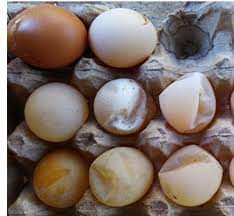EGG DROP SYNDROME (EDS): A THREAT TO LAYING HENS
Dr. Amit Ranjan, PhD (Animal Nutrition), Patna, Bihar
E-mail: narsidhant@gmail.com; Mobile: +91-9939337208
Egg drop syndrome (EDS) is caused by a viral infection in laying hens. It is characterised by a sudden drop in production of eggs as well as its egg shell quality or a failure to achieve a normal peak in production in apparently healthy birds. Mortality is usually negligible. It can be difficult to identify the early stages of the disease. Ducks and geese are the natural hosts for the EDS virus and are asymptomatic carriers.
Etiology:
Egg drop syndrome is induced by double stranded-DNA virus, called duck adenovirus 1 (also known as EDSV), which belongs to the genus Atadenovirus that replicates primarily in lymphoid tissues and massively in the pouch shell gland region of the oviduct, producing eggshell changes (loss of shell pigmentation, thin and soft shells, and shell-less egg). The diameter of the virus is between 70 and 80 nm by negative staining. The incubation period is three to five days and the course of the disease is 4 to 10 weeks.
Epidemiology & Pathogenesis:
Three patterns of disease are recognized in chickens:
1. Classical EDS: Occurs when primary breeding stock is infected and the virus is transmitted vertically through the egg. The virus often remains latent until the progeny chick reaches sexual maturity, at which time the virus is excreted in the eggs and droppings, infecting susceptible contacts.
2. Endemic EDS: is the result of horizontal infection of the flock during lay. It is usually seen in commercial egg layers. Contaminated egg collection trays are one of the main vehicles of horizontal transmission between flocks because virus can survive both inside the eggs and on the eggshell. The virus can migrate from the eggshell to the tray and back to the other eggs placed in the same tray. Humans and contaminated fomites (such as crates or trucks) can spread virus, which can also be transmitted by needles when vaccinating and drawing blood. Insect transmission has not been proven but is considered possible.
3. Sporadic EDS: has been recognized occasionally in flocks. This is due either to direct contact with domestic ducks or geese or, more often, to use of a water supply contaminated with wildfowl droppings. Although infection by this route is uncommon, there is always a risk that these introductions of the virus could form a starting point for endemic disease.
Sign & Symptoms:
• Egg drop at peak or failure to peak. Drops may be of 5 to 50% and last for 3-4 weeks.
• Loss of shell colour pigment in the eggs
• Loss of egg yolk pigment
• Production of thin or soft-shelled or even shell-less eggs
• Shell-less eggs are so fragile and thus may get eaten by the chickens and get disregarded as litters.
• The shells may also be rough or chalky
• Watery egg whites
• Reduction in egg size
• Poor internal quality (Loss of egg yolk pigment)
• Transient diarrhoea, anaemia, and loss of appetite
Post-mortem lesions:
• Lesions include inactive ovaries and atrophied oviducts, uterine oedema, exudate in the shell gland, flaccid ovules and a mild splenomegaly (enlarged spleen).
• Histopathology – it may be possible to demonstrate degenerative changes in the epithelial cells of the magnum of the oviduct
Diagnosis:
• History, signs/lesions (mainly lack of). Isolation of haemagglutinatin agent in duck eggs or cell culture, group antigen distinct from classical adenoviruses (white cells, throat swabs, oviduct).
• Serology:
Haemaglutination-Inhibition, Serum Neutralisation, Enzyme-linked Immunosorbent Assay. It is important to rule out other possible reasons for egg drop, which can be caused by a large number of factors acting individually or in combination.
• Management problems may be involved:
Inadequate water supply, extremes of temperature, inadequate lighting programme and sudden changes of feed.
• Nutritional deficiency should be considered, specifically vitamins E, B12, and D as well as Calcium, Phosphorus and Selenium.
• Diseases in which egg drop occurs, may be infectious or metabolic;
Infectious diseases: It include Infectious Bronchitis, Infectious Laryngotracheitis, Avian Encephalomyelitis, Newcastle disease, Marek’s disease or any infectious disease causing a significant systemic disturbance (CRD, Coryza, Cholera, Parasites, Diphtheritic Fowl Pox).
Metabolic diseases: It includes Fatty Liver Syndrome, Intoxication by Sulphonamides, Insecticides or Nicarbazin.
Treatment:
There is no successful treatment of EDS. Soluble multivitamins may be recommended as a non¬specific measure.
Prevention & control:
An inactivated vaccine with oil adjuvant can be administered. This vaccine is given before hens start to lay eggs, usually between 14 – 18 weeks of age. The classical form has been eradicated from primary breeders and the maintenance of EDS-free breeding stock is the main control measure. In layers, induced moulting will restore egg production after an episode of EDS infection.
Hygiene:
Cleaning all areas, such as breeding and laying areas and equipment may mitigate the risk of getting EDS. Shared egg trays have to be cleaned and disinfected prior to use. Healthy and uninfected flocks should be kept away upon a contact with those affected birds and the virus natural host. Potential contaminated water should also be chlorinated.


